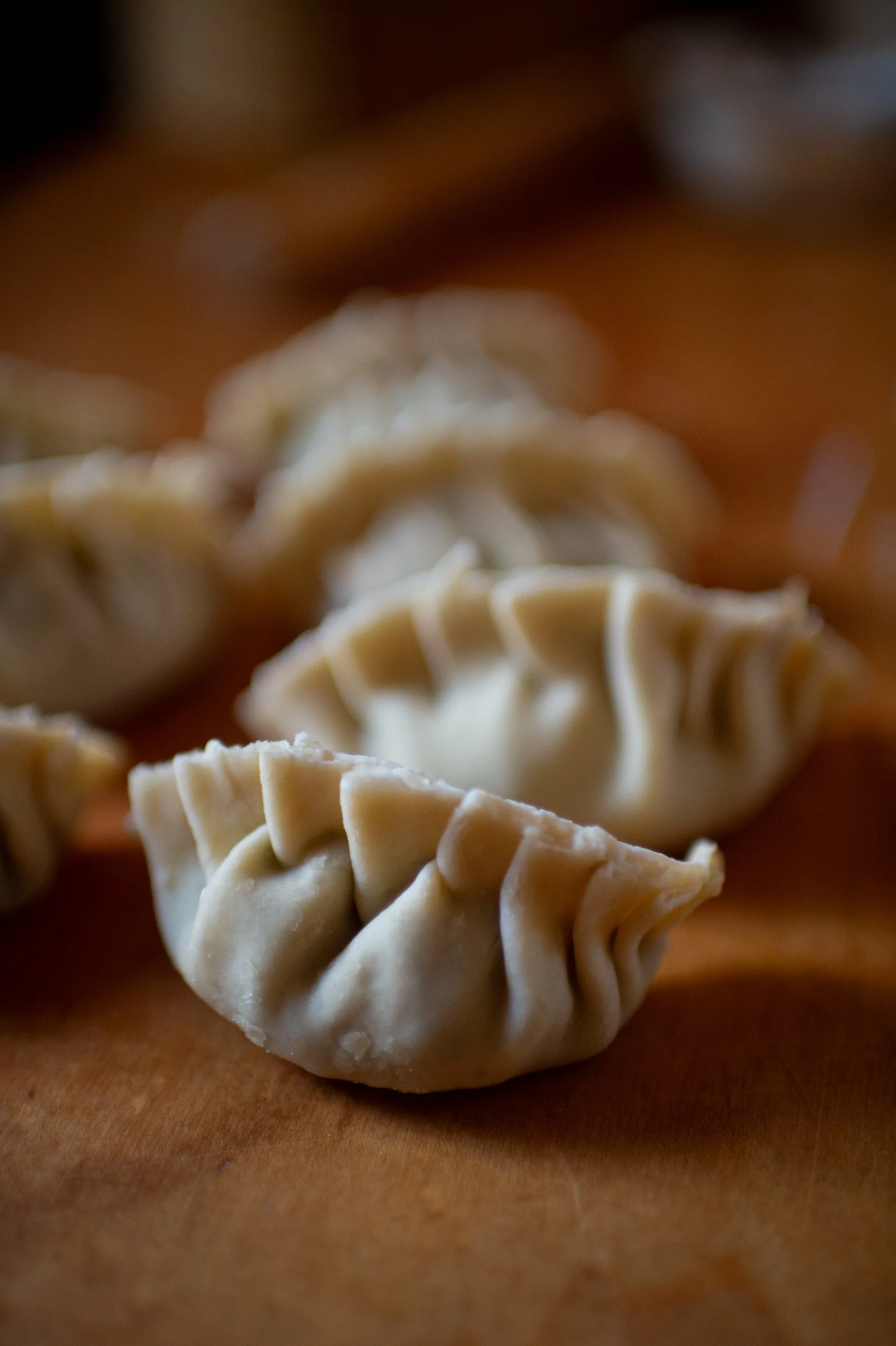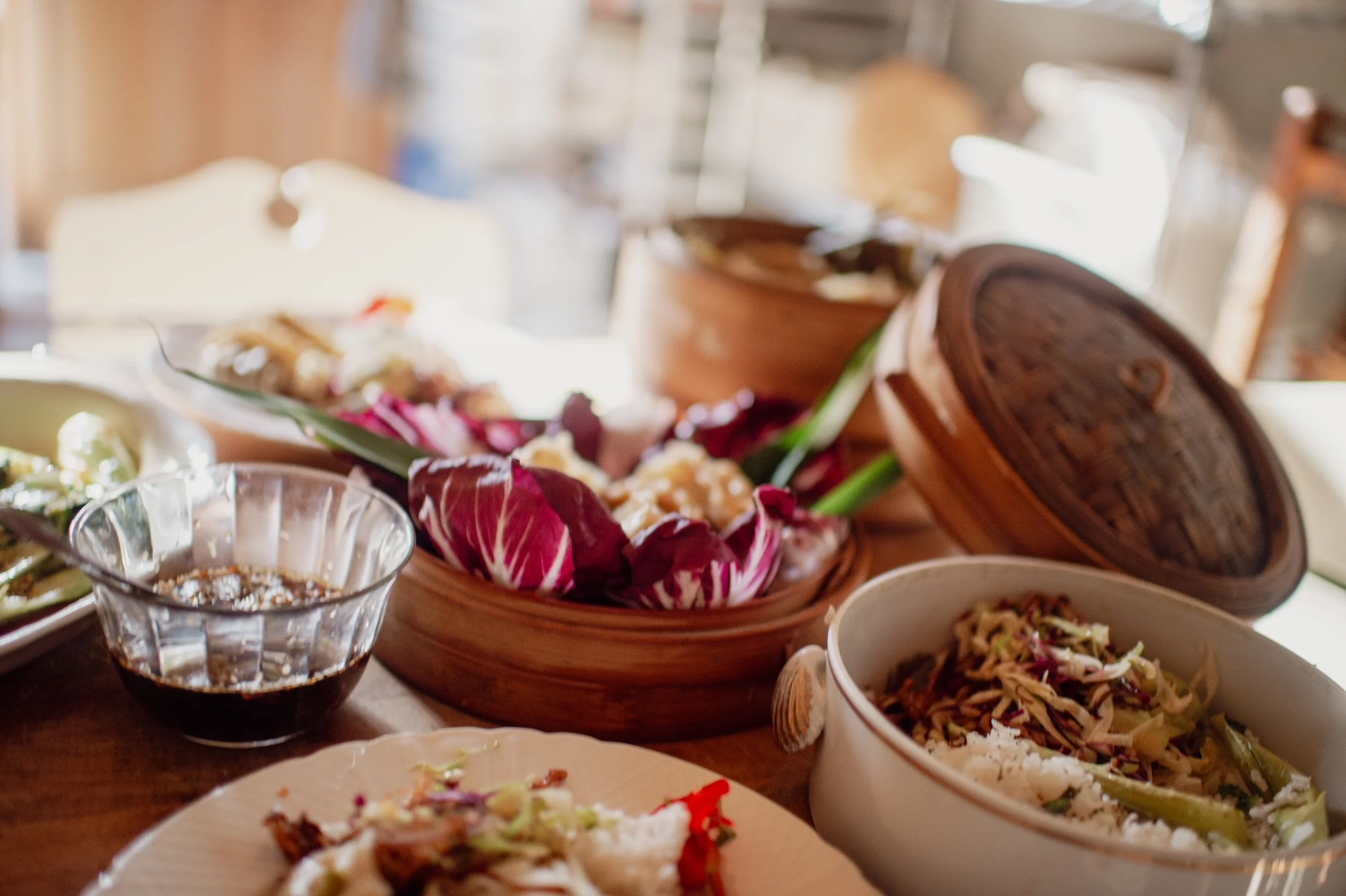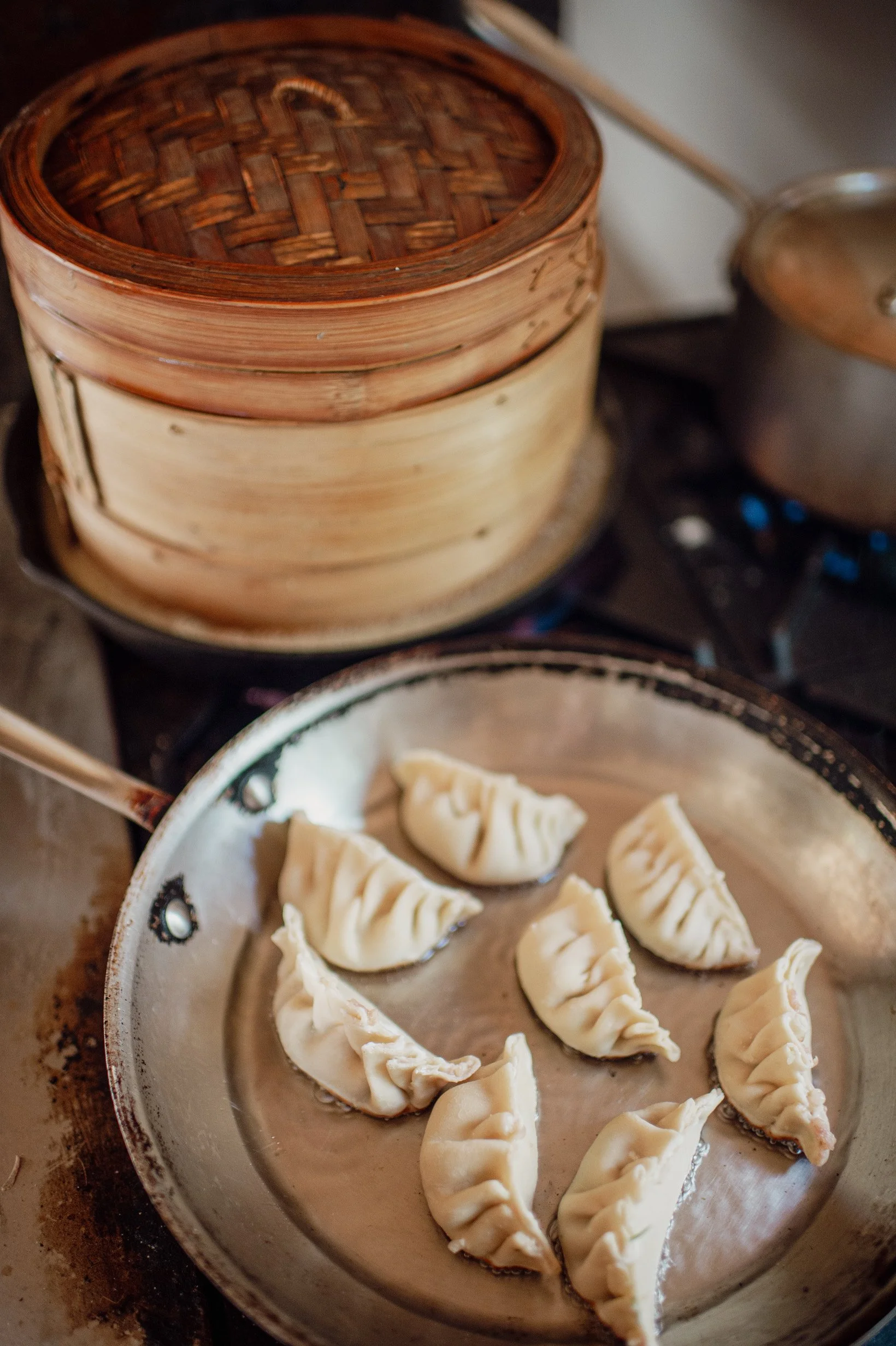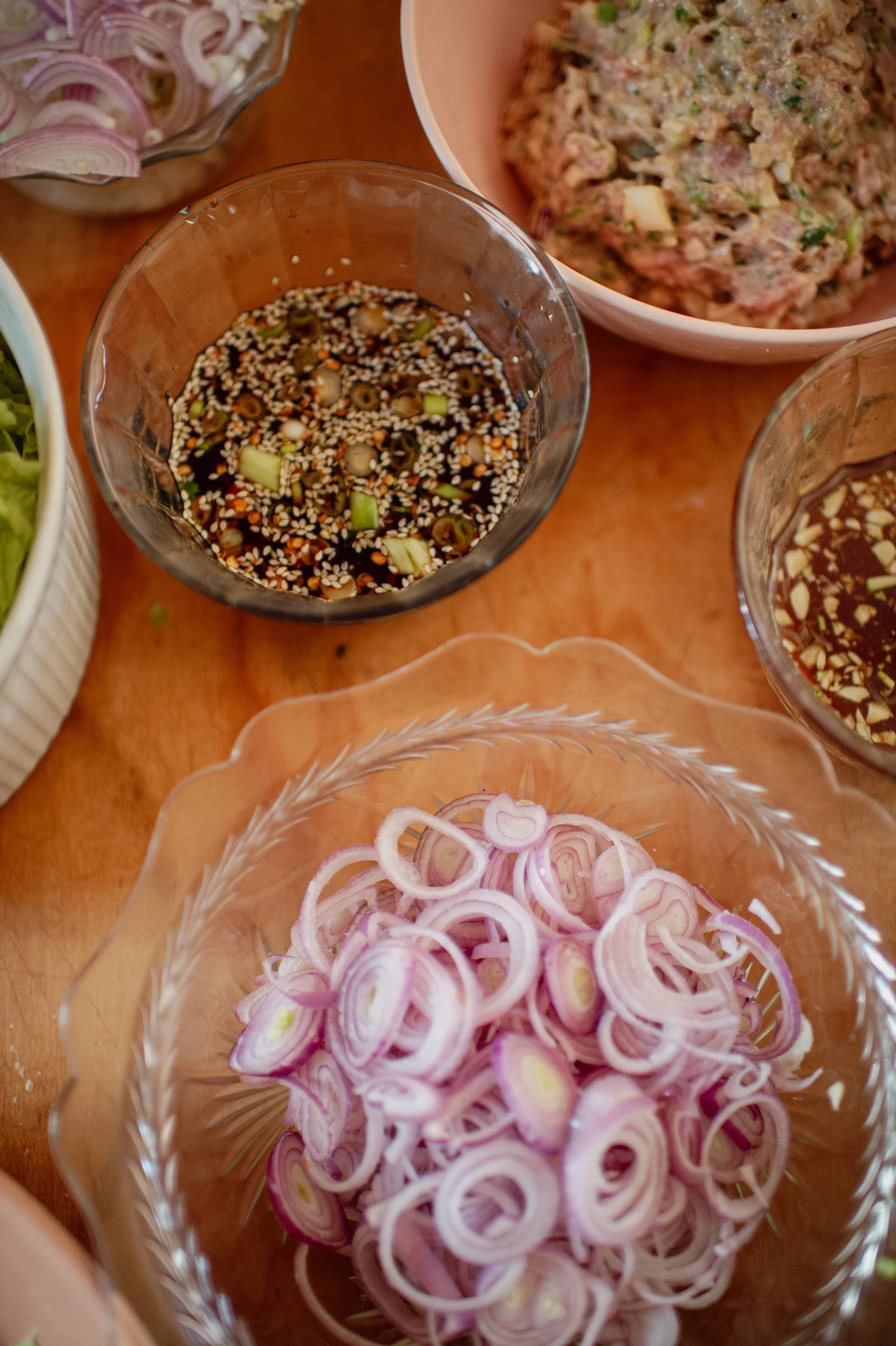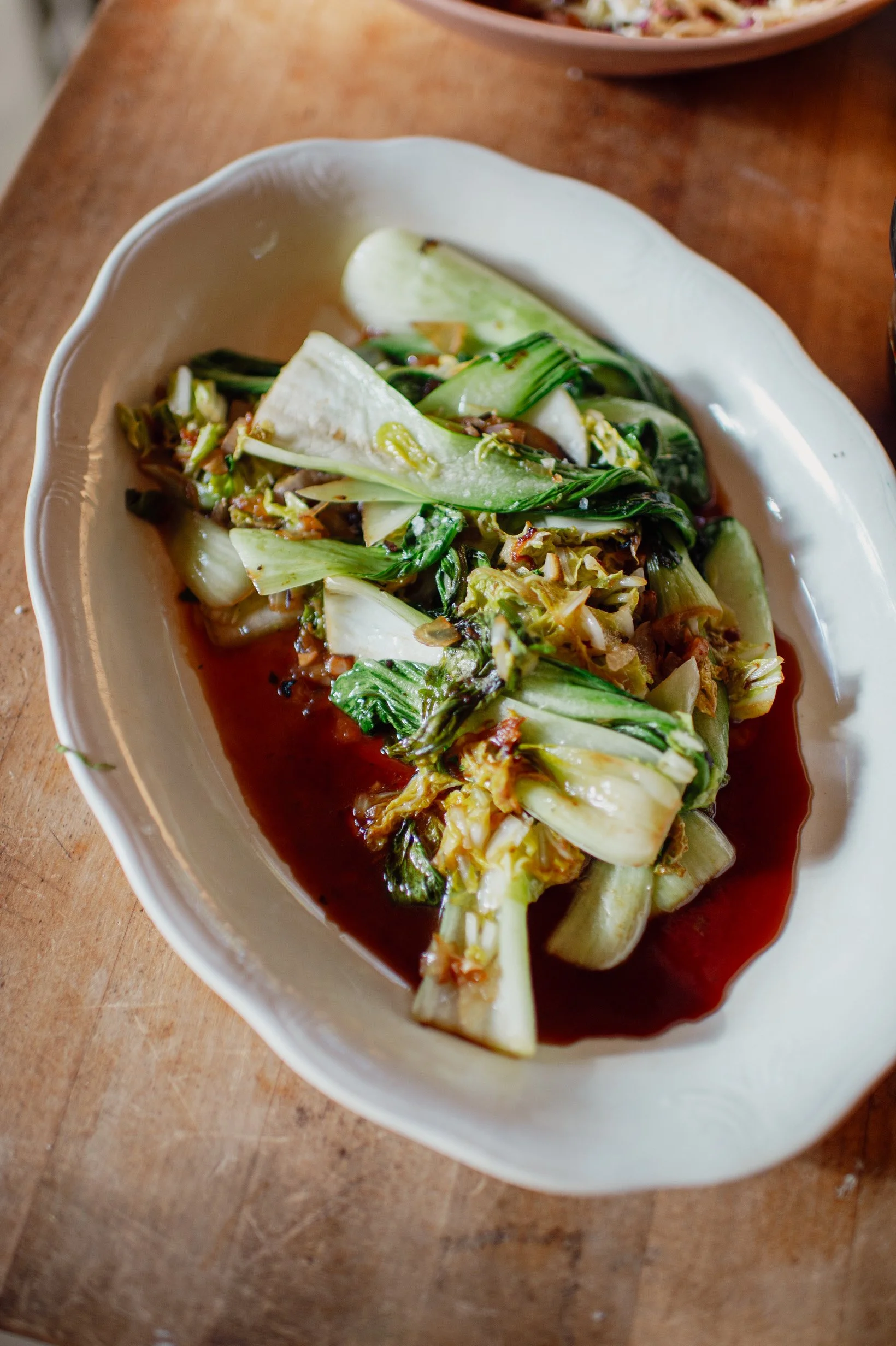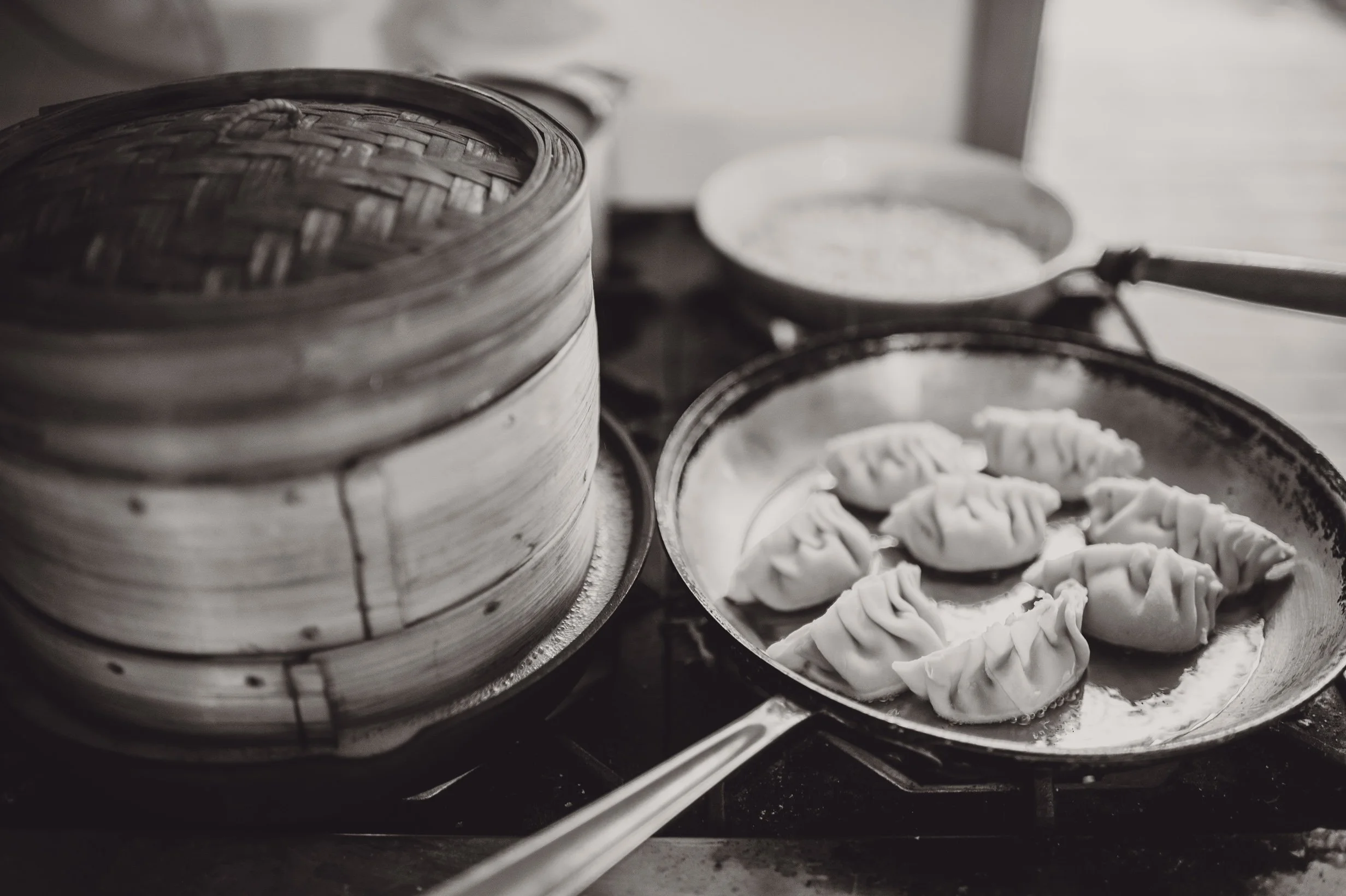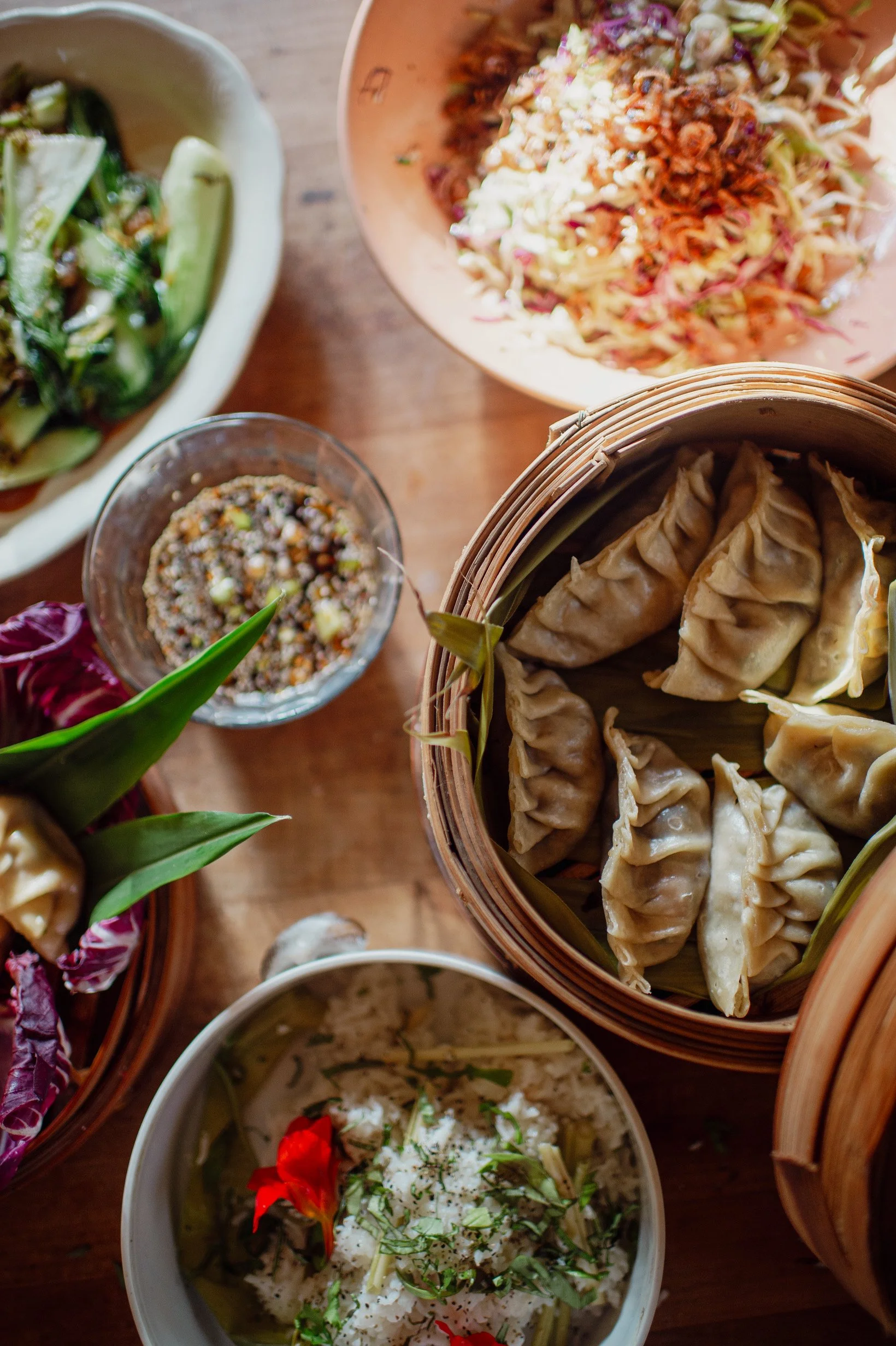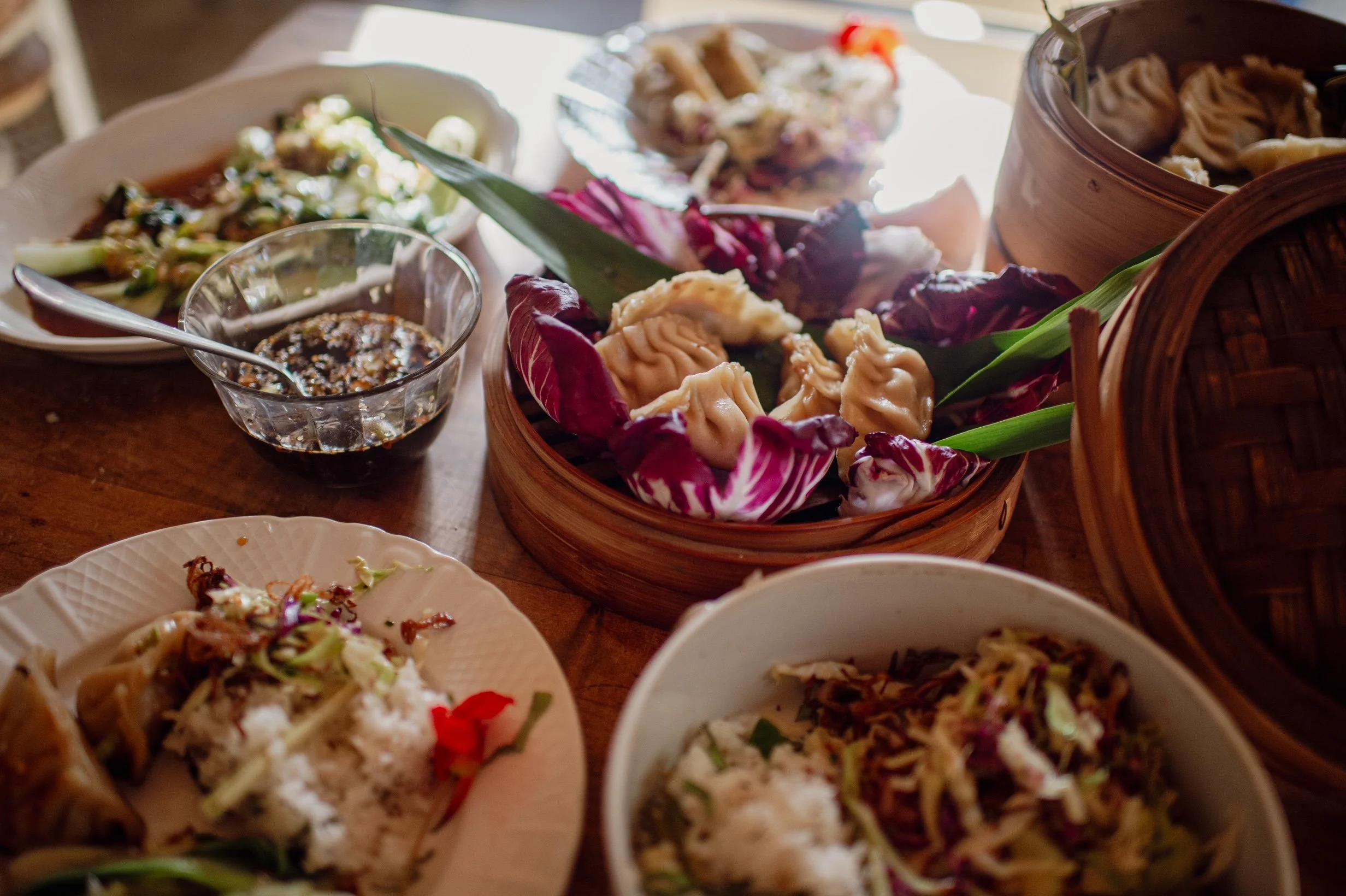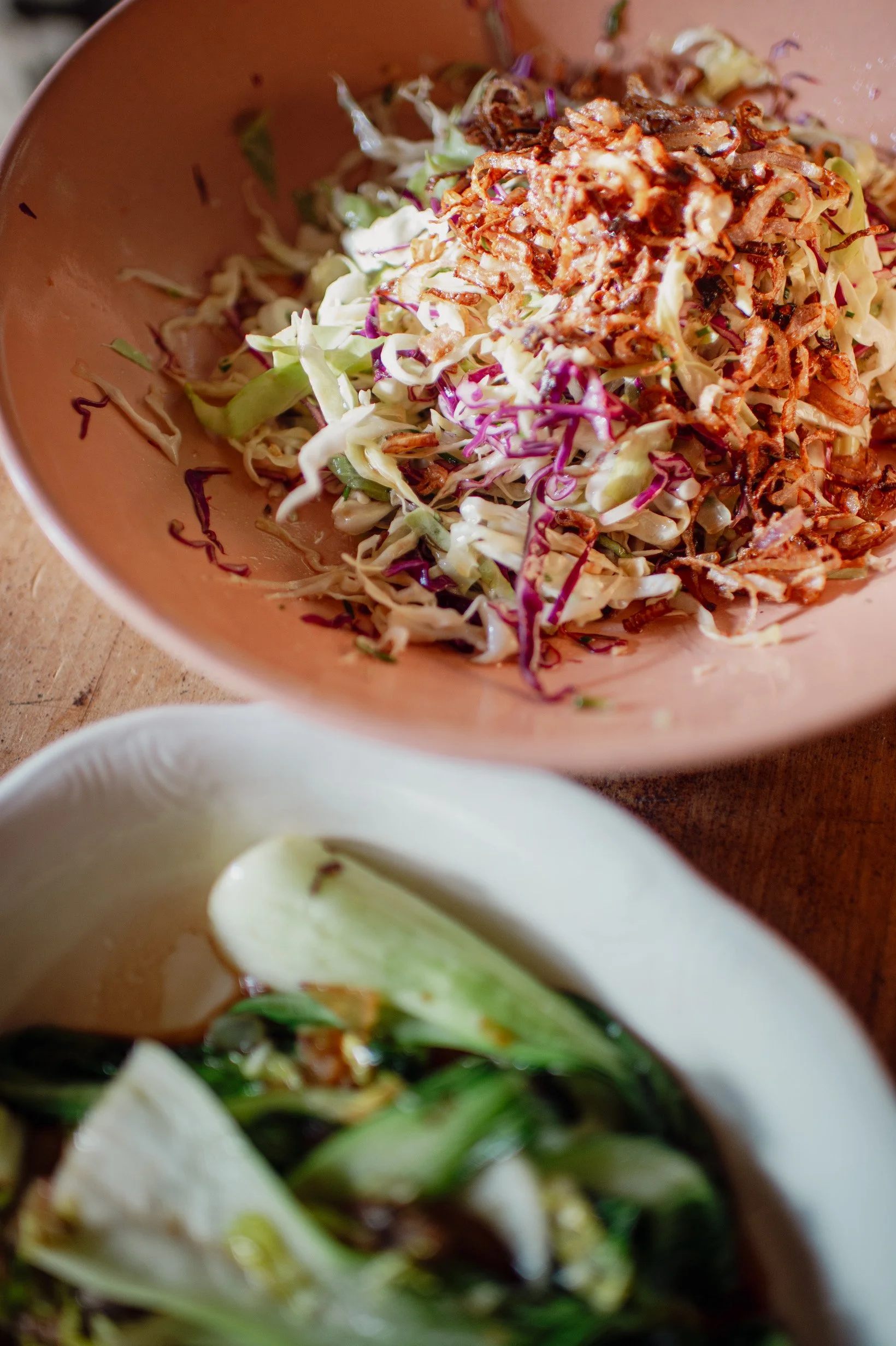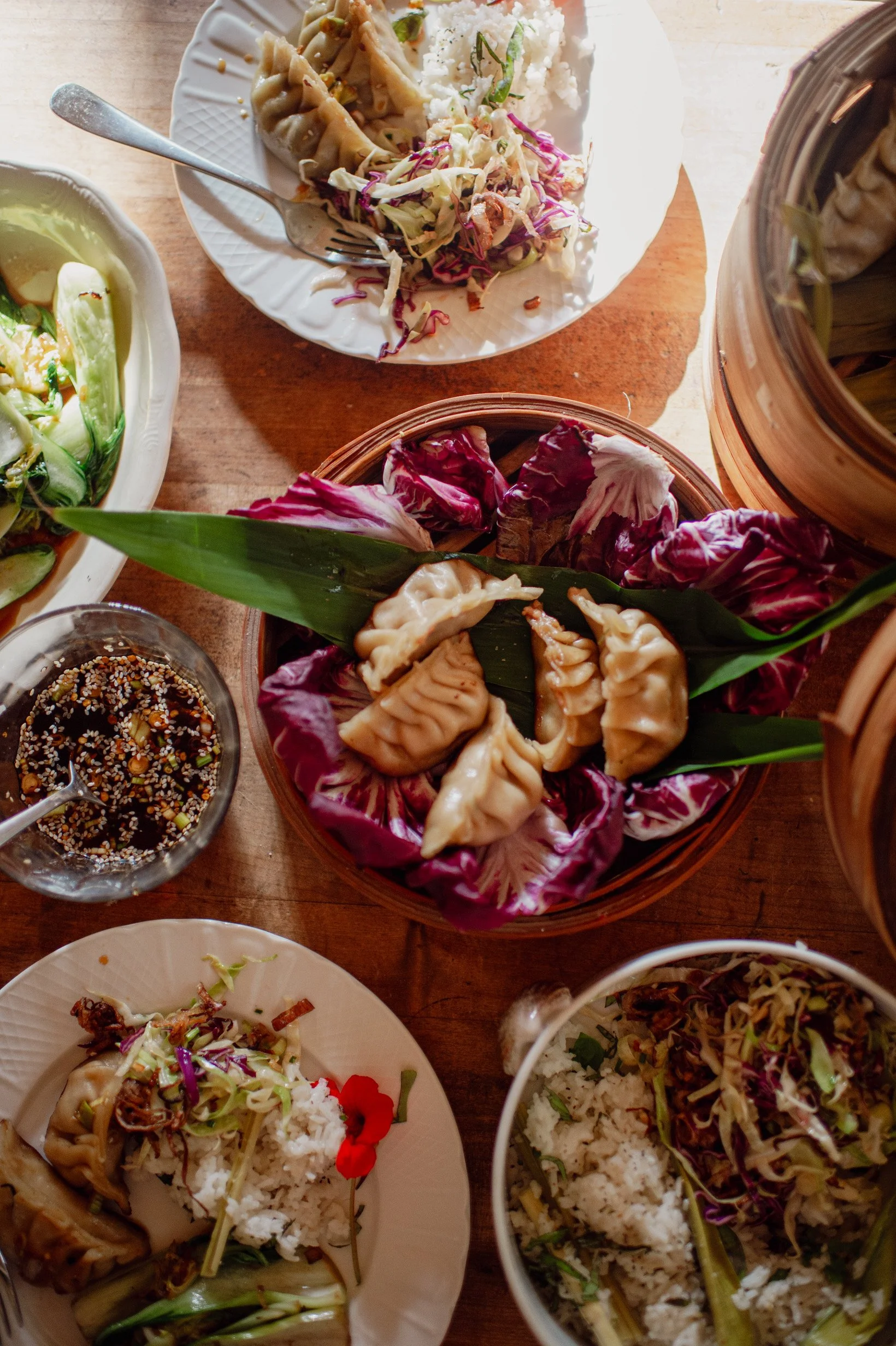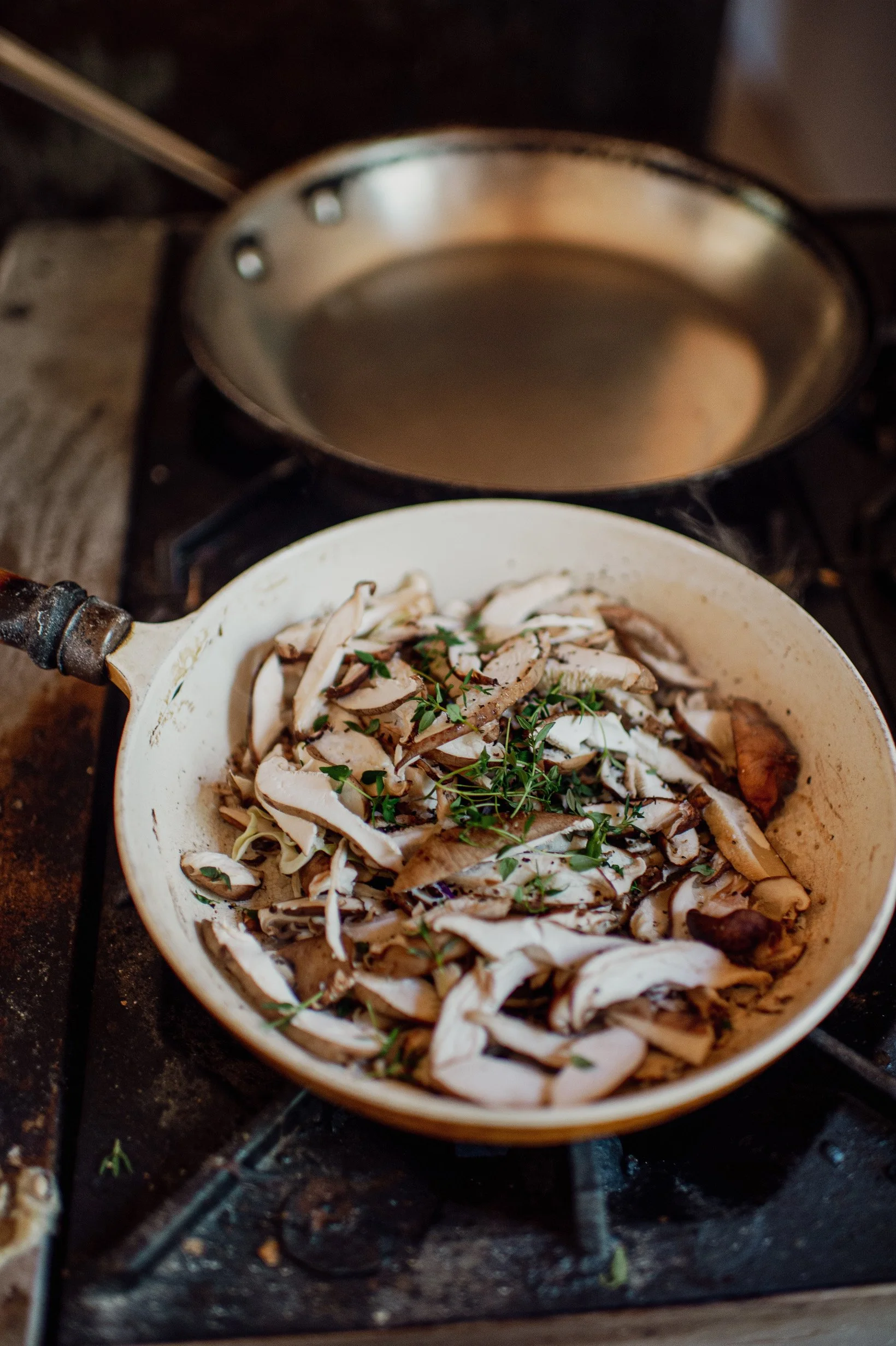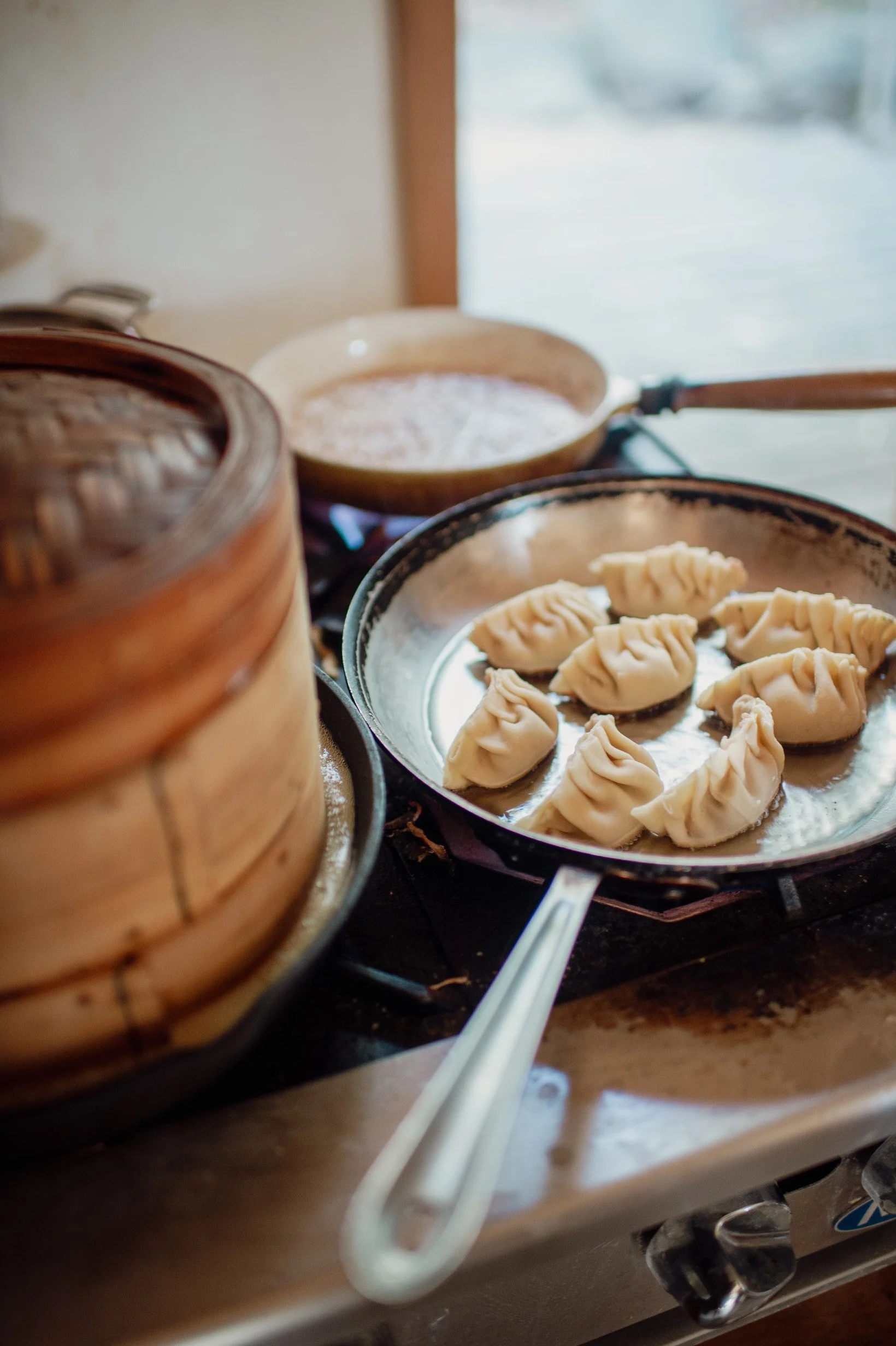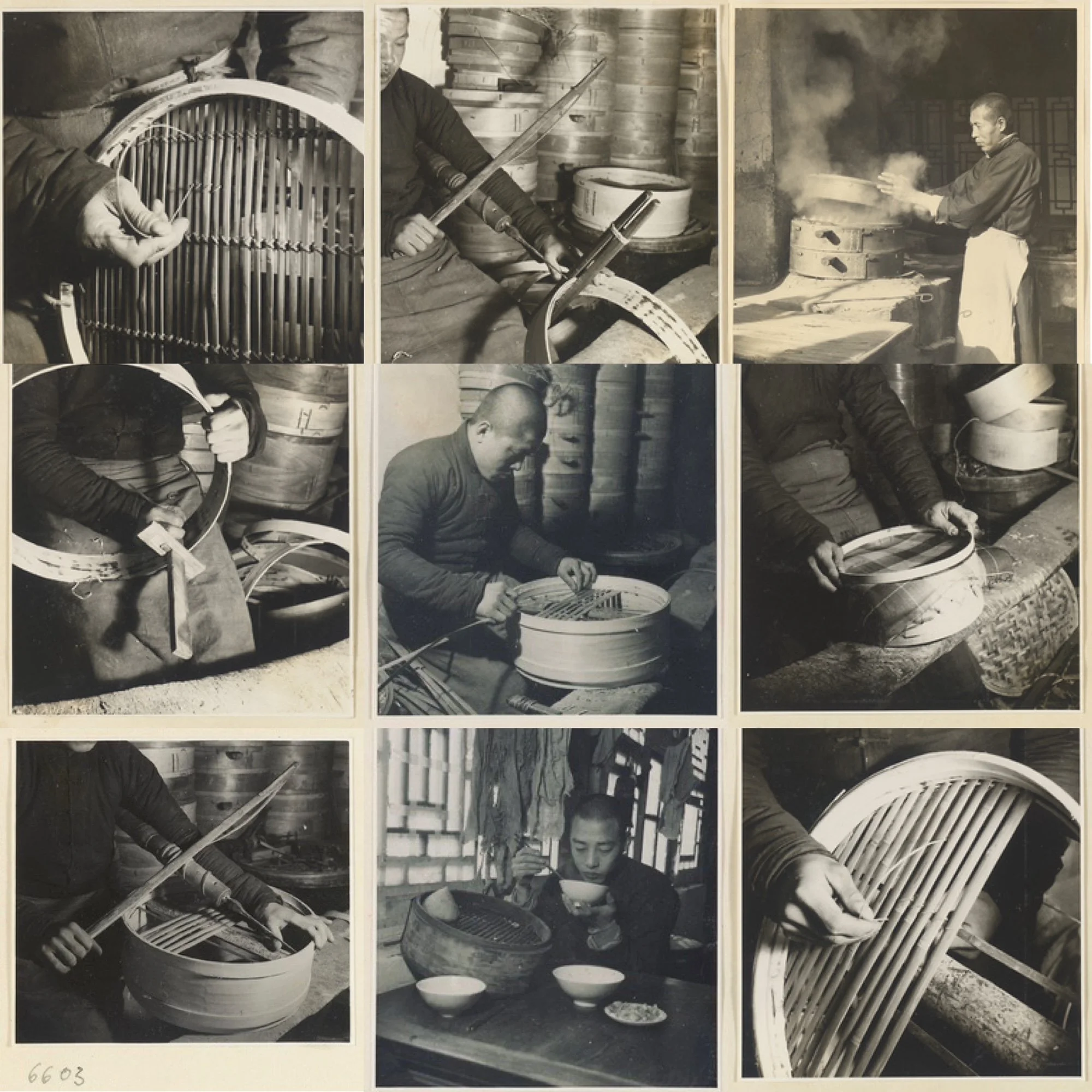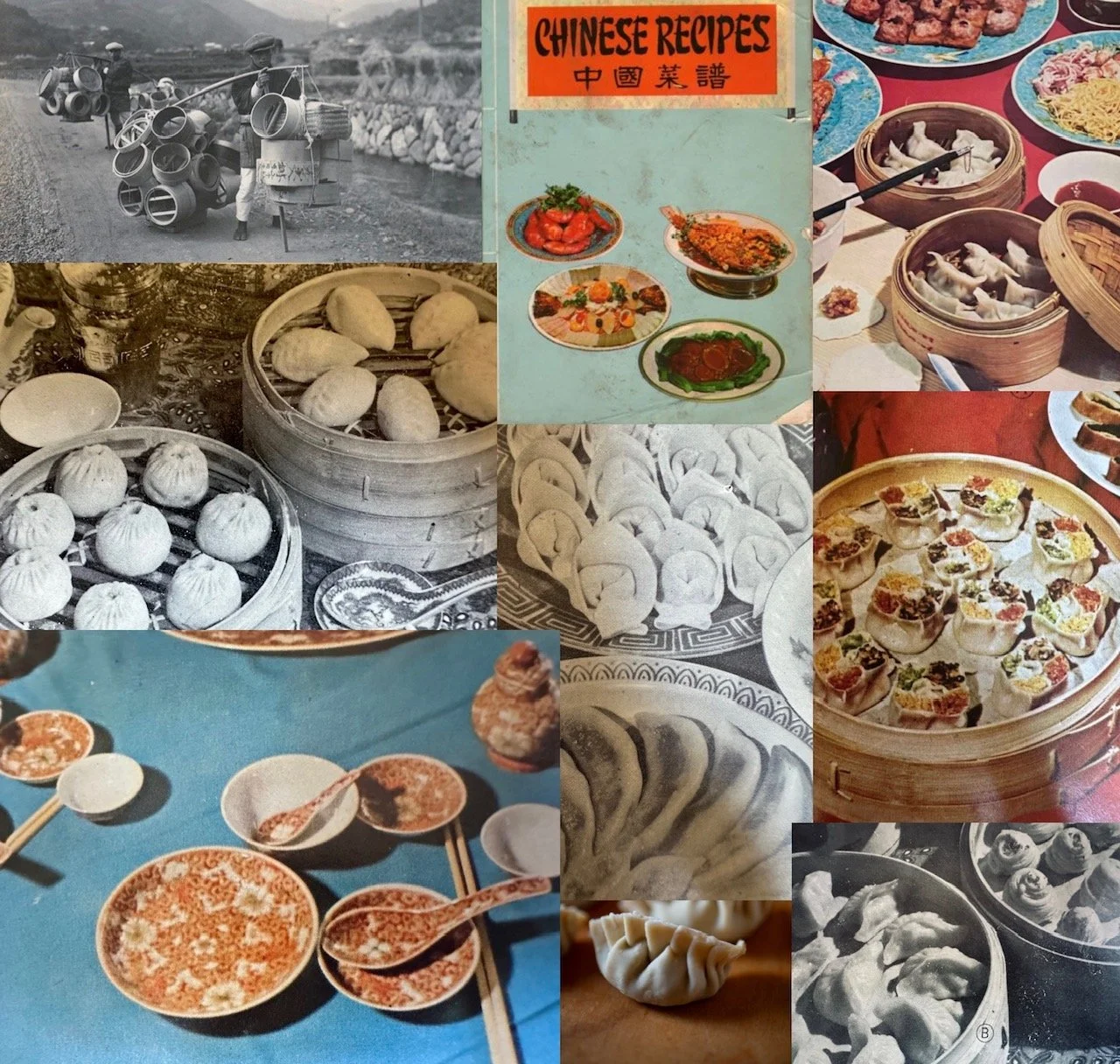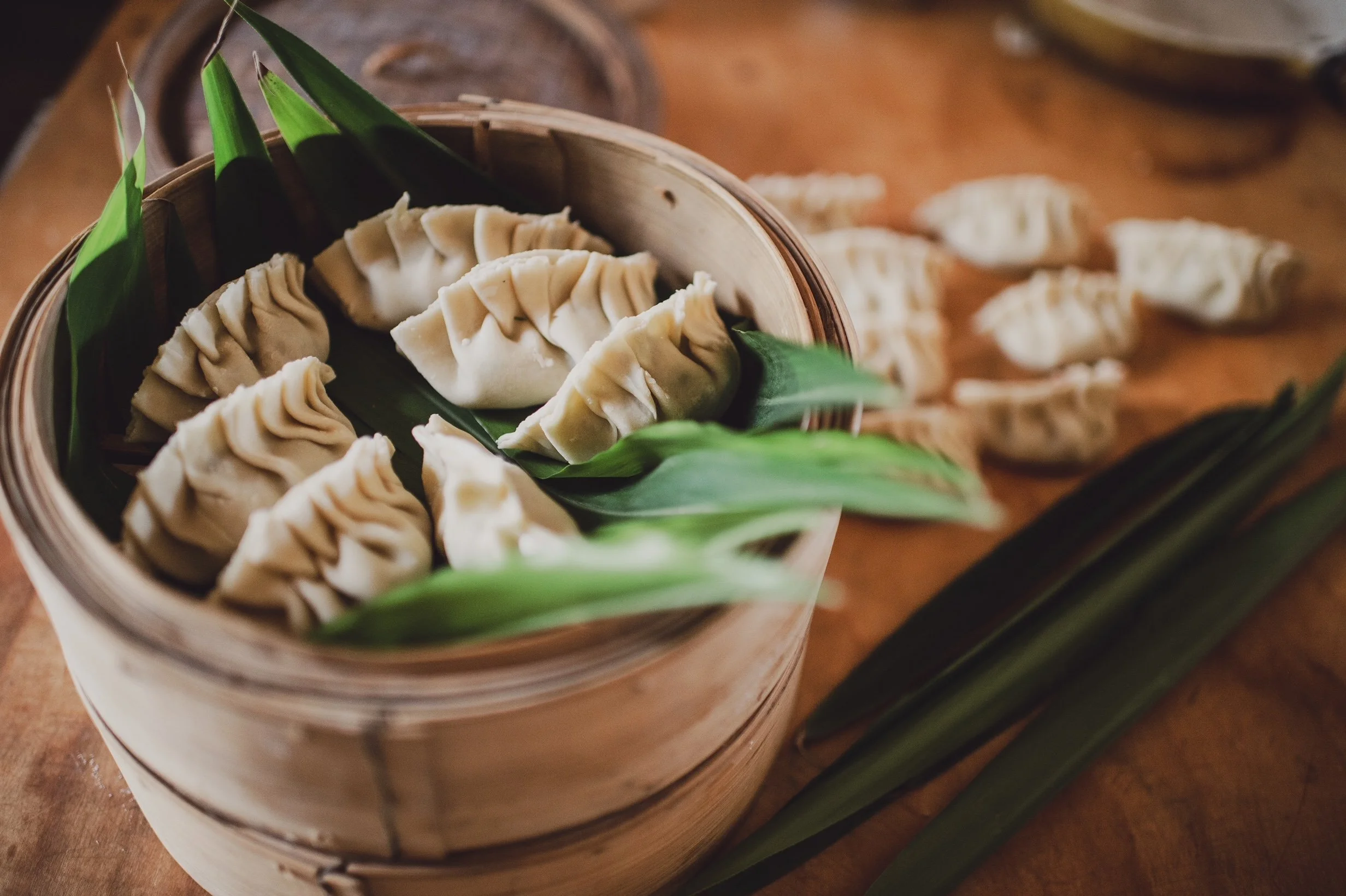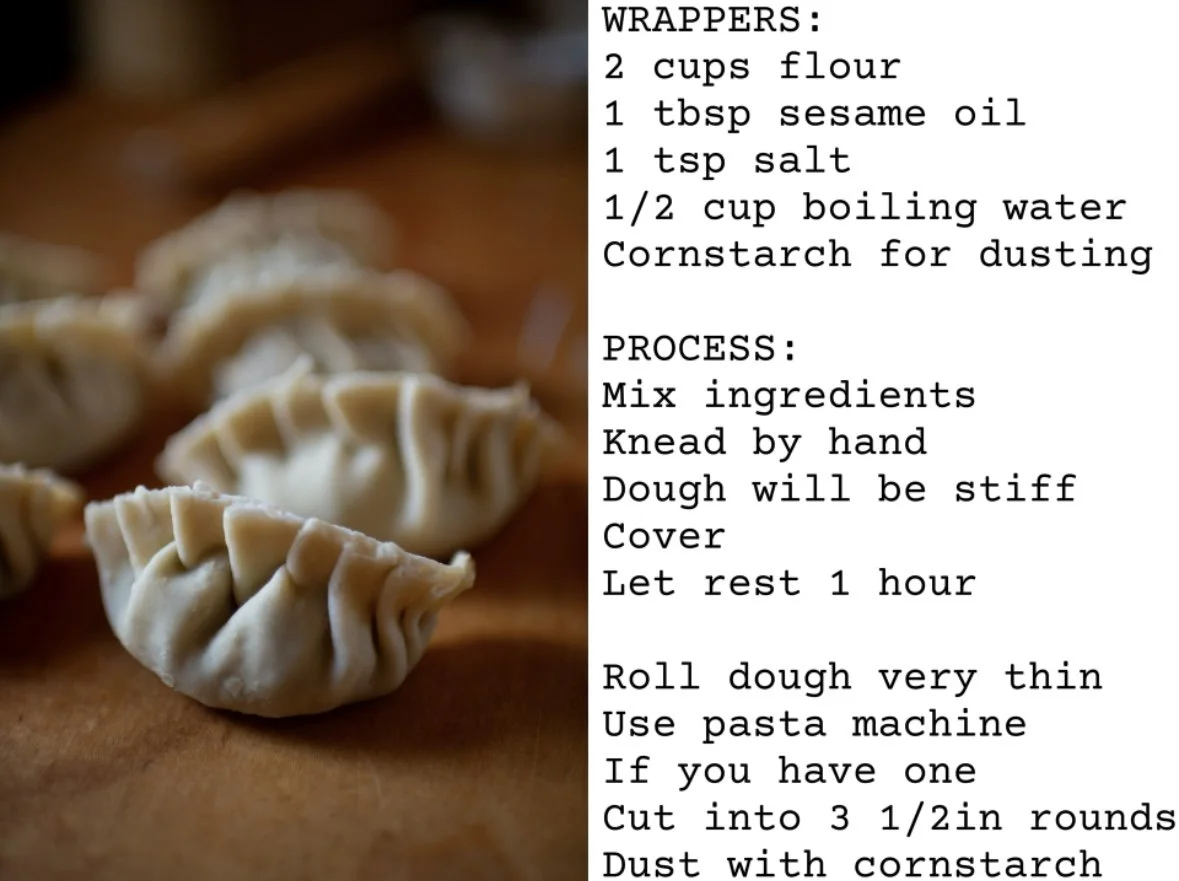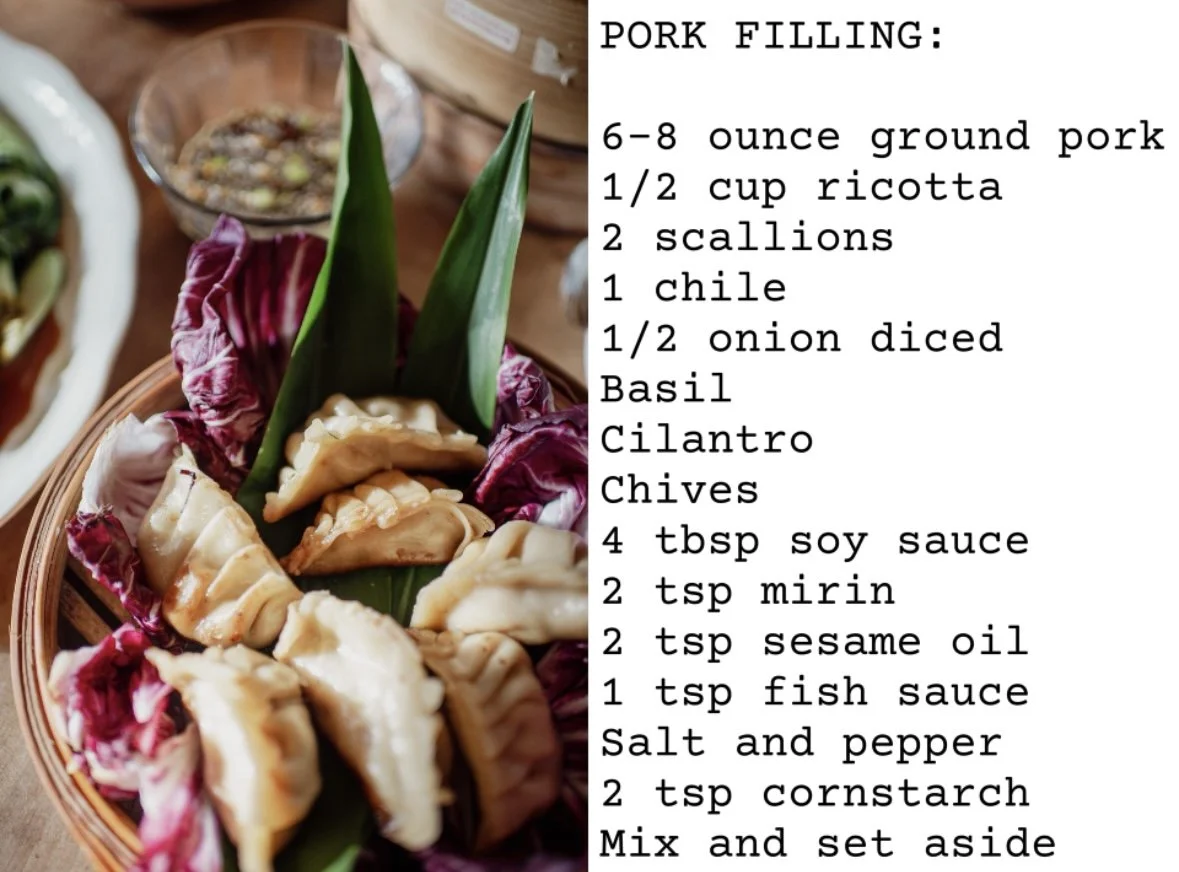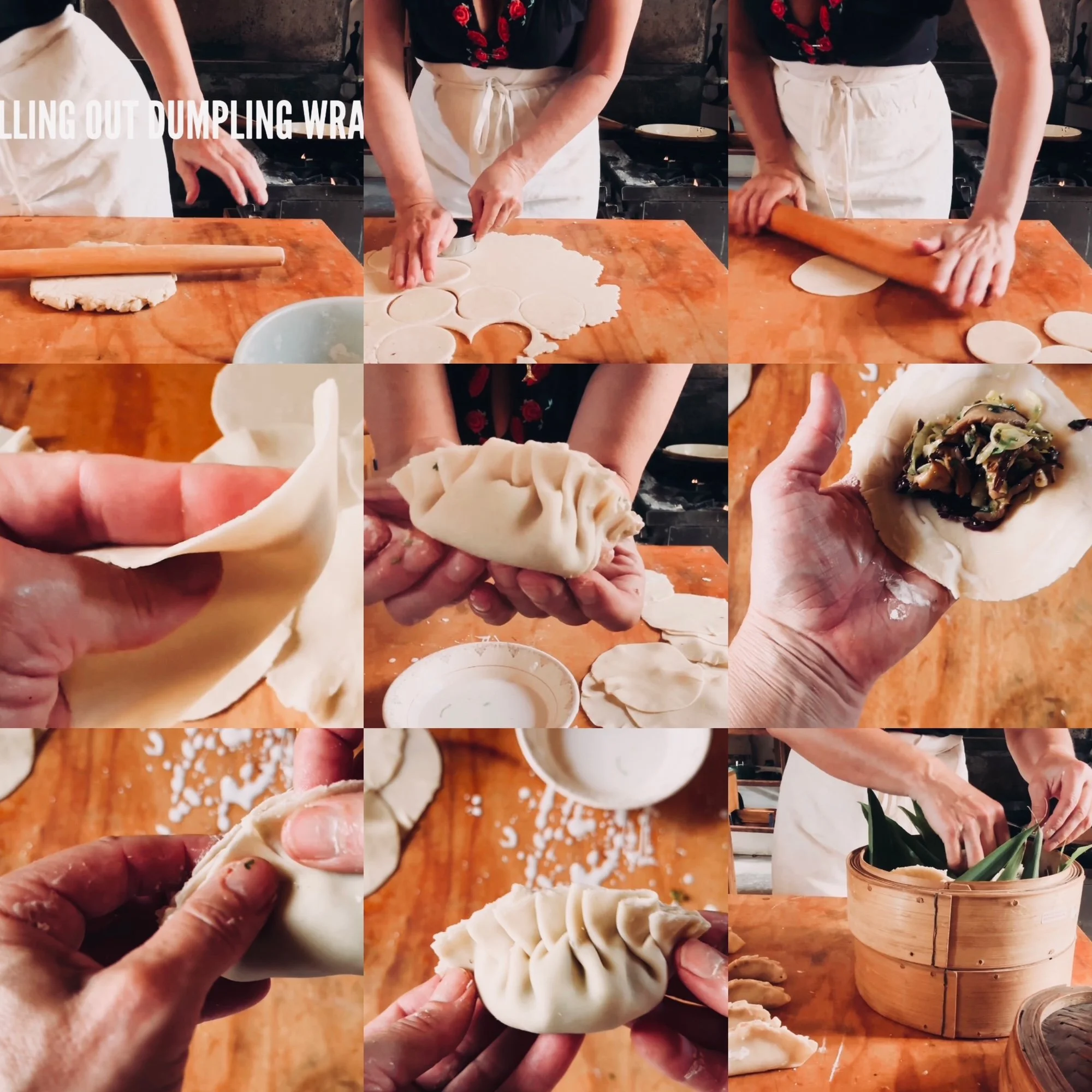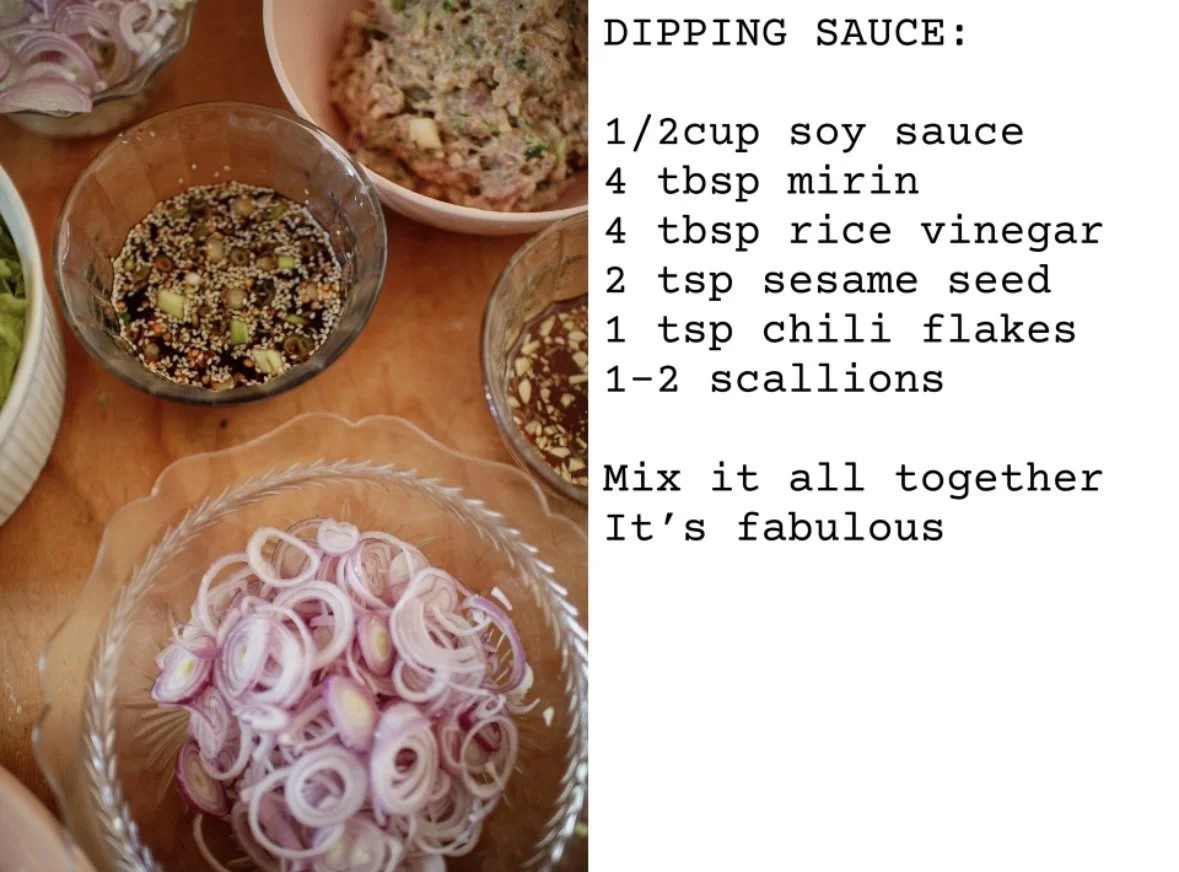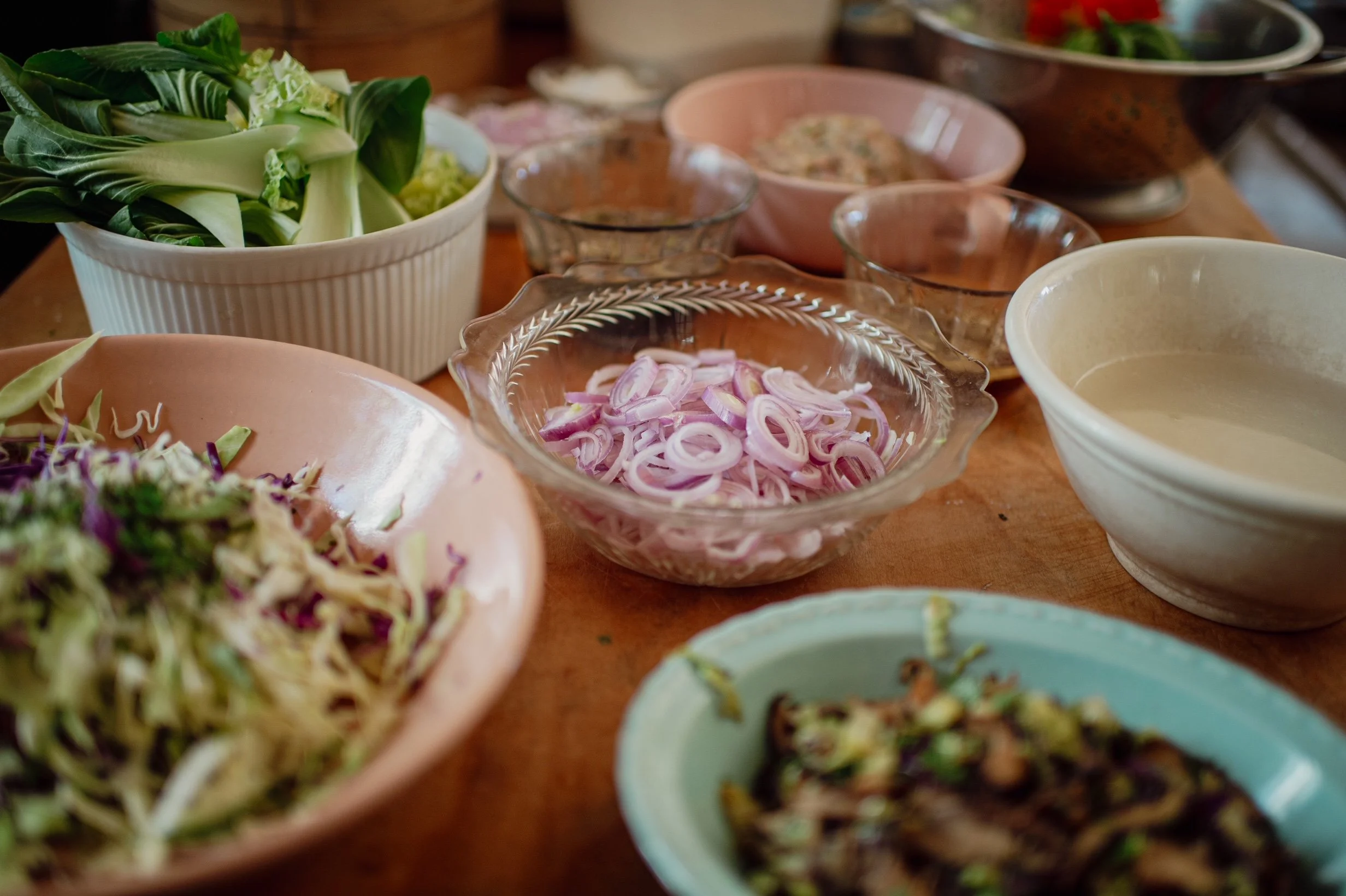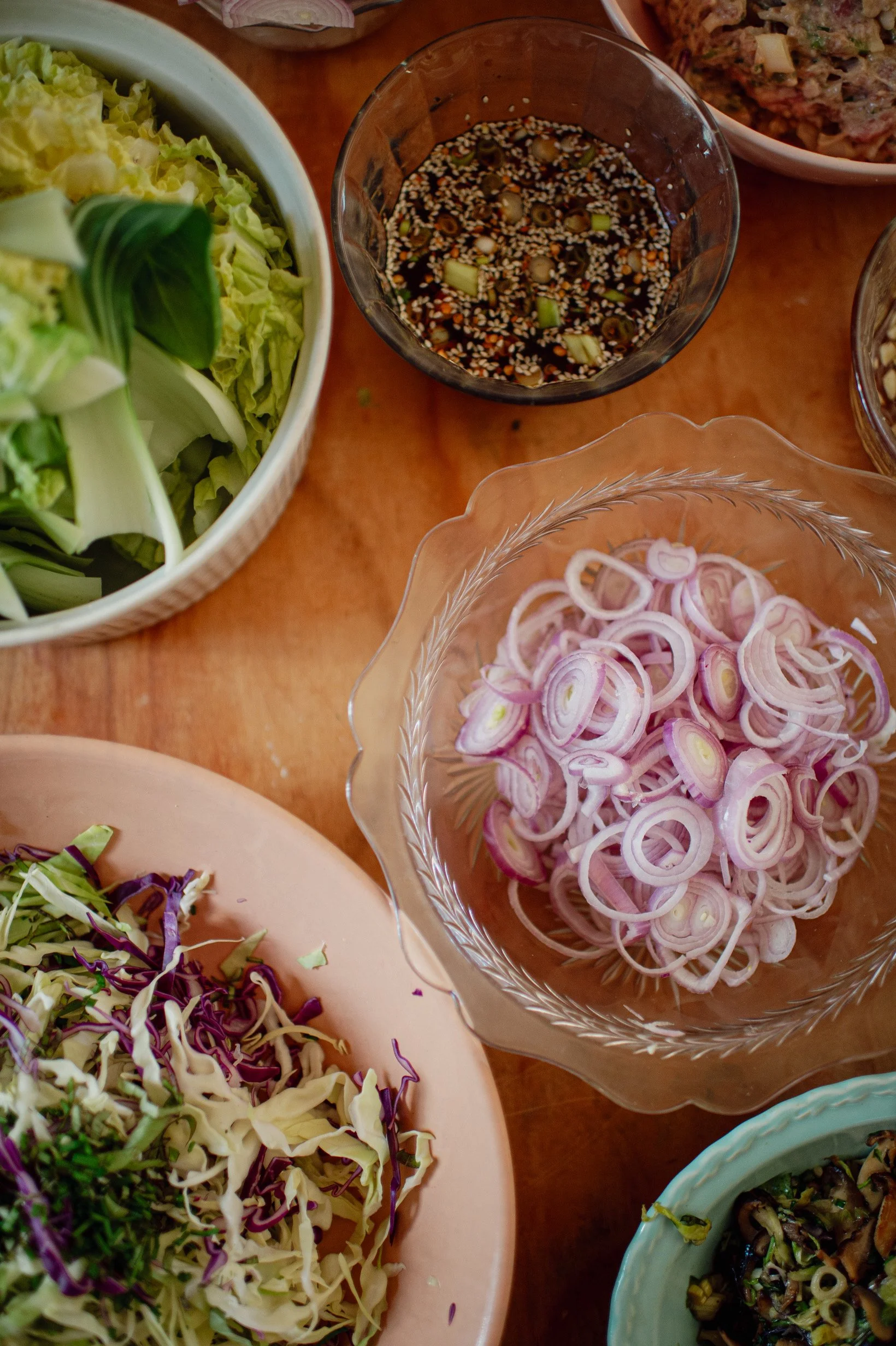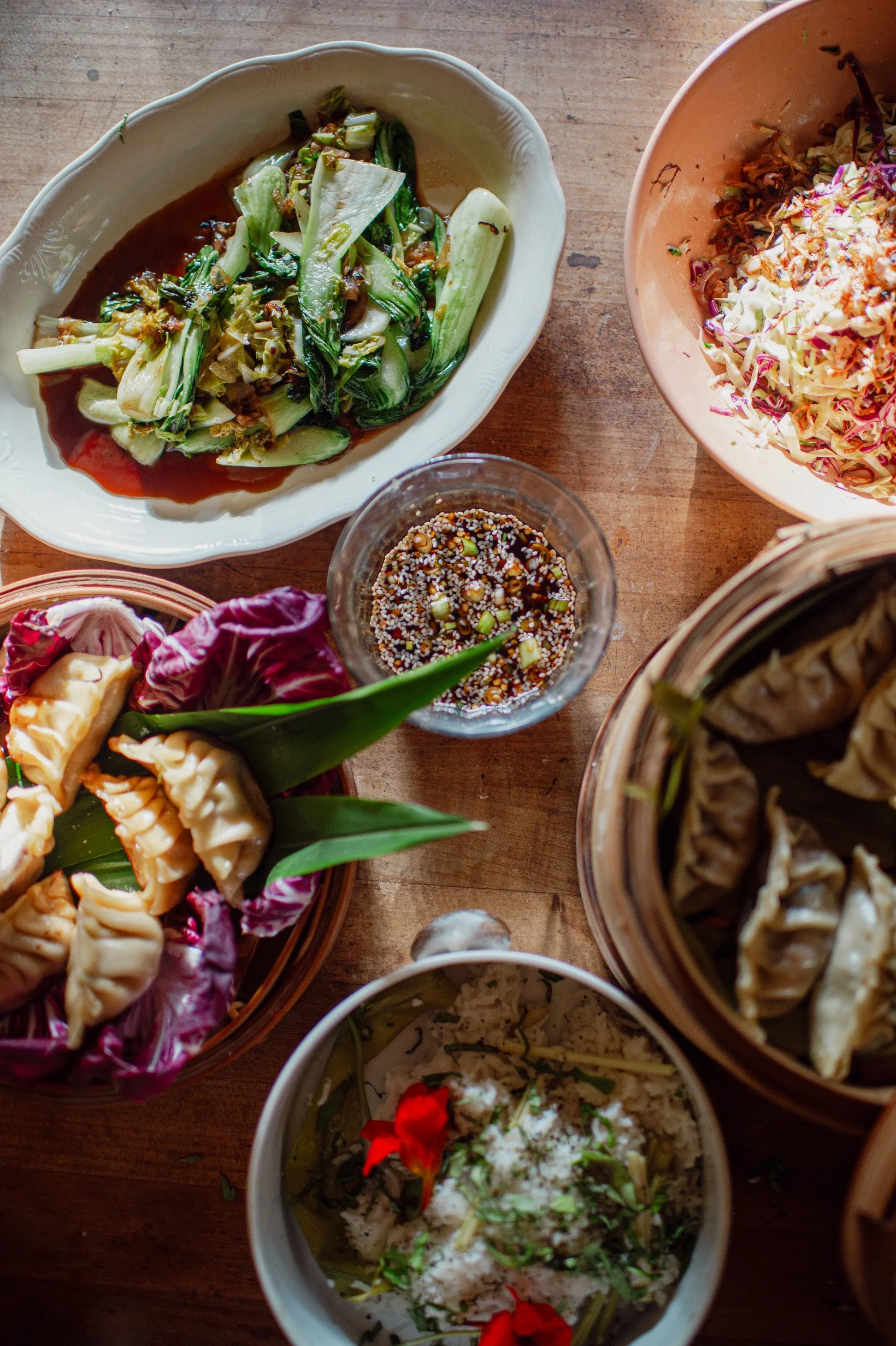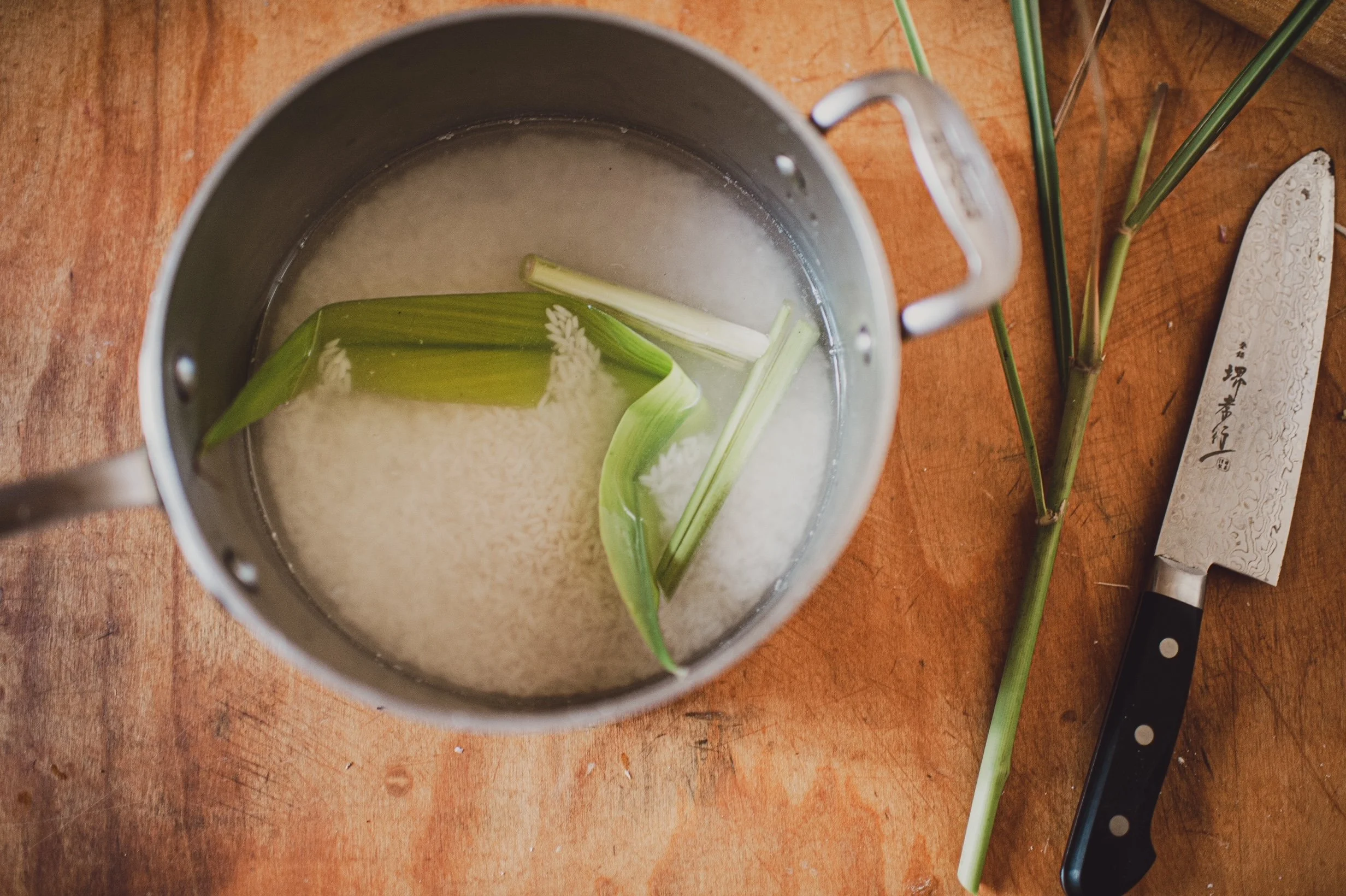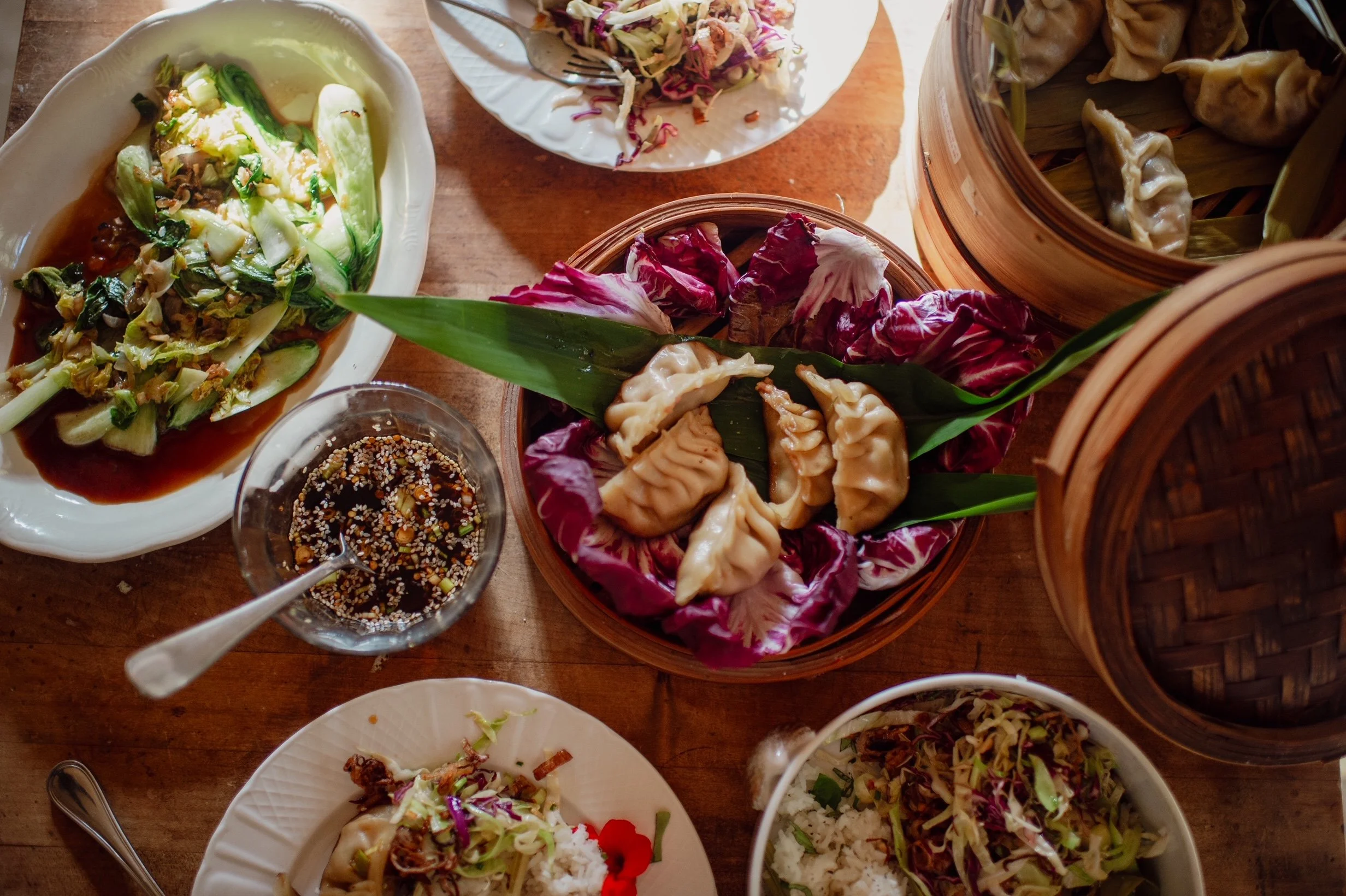DUMPLINGS
* * * * * * * * * * * * * * * * * * * * * * * * * * * * * * * * * * * * *
* * * * * * * * * * * * * * * * * * * * * * * * * * * * * * * * * * * * *
DUMPLINGS BEFORE FLOWERS
A KITCHEN EXPERIMENT: PORK AND VEGGIE DUMPLINGS
I have never made dumplings before. I have made sweet and savory hand pies that package up the goods in a nicely seamed piece of dough but that is as far as i have gone. I have also attempted different varieties of doughs from different cultures, such as naan or roti, chapati, tortillas, puff for aussie sausage rolls, empanadas and samosa handpies too. I find myself curious about doughs and how they fit into our kitchens in different variations. Culturally it is so different all around the world and yet so much is the same. I had yet to try asian dumplings, until a few days ago.
My interest in this dough peaked a few years ago when I found a simple looking recipe in the New York Times recipe section. I decided I would try it. It has taken me three years to get to it, but I felt it was time.
My project stemmed from an interest in dough, but found it’s way to a fascination with the bamboo steamer I had only ever used for a prop basket and a little dive back into some asian greens I have always been fond of. Dipping sauces and dressings, all which can work with so many other dishes as they are simply delicious. You can work the asian dressing into a slaw not dissimilar in looks to the classic cole slaw on the salad staples page but very different in flavor. You can make some kim chi, in the recipe archive, as a filling additive or a simple side with the rice and sauteed pac choi and chinese cabbage. I found myself diving into a slew of herbs that can easily be grown in your own back yard as well as scavenging for lemon grass from an old plant in the neighbor’s yard and cardamum leaves from my mother’s decorative cardamum plants along the side of the house. I could have kept everything simple and just made a dumpling but the adventure of the project was as inspiring as the cooking itself.
I am not writing this as a tutorial necessarily, as I am learning myself. I would prefer to call this an experiment. Dipping my toes into a culinary world I know little about and finding my way through all of the trials and tribulations. So much of what I tried worked and tasted divine and yet other things need a tweaking. This is how we begin to learn how to cook. This is how we begin to understand our culinary staples and personal menus that define our kitchens, through trial and error.
I am going to give you the recipes I worked with here. I am going to show you the mayhem of my dumpling meal in a longer video than I had hoped for. I am going to explain what went right and what could be better and how I might go about making the changes.
Over all, I am happy with the outcome. I am happy to know a new dough and to have gotten my hands into it with little to no knowledge of what it is supposed to be like. This grows confidence for a next time.
* * *
* * *
* * * * * *
THE BAMBOO STEAMER:
It is said that the bamboo steamer was introduced during the Han Dynasty (202 BC-195 BC). It was a request by General Han Xin who ordered new cookware to be made from bamboo and the application of heat to be steam so as not to expose the location of his army through cooking fumes and smoke. It became a practical way of cooking as the bamboo easily absorbs the moisture and prevents condensation from dripping onto the food. The practice of making a steamer takes roughly 20-30 minutes to make so they were easy to produce with a material that was quick and easy to acquire. Bamboo is the world’s fastest growing plant so as a source material it regenerates quickly.
DUMPLINGS:
The first mention of dumplings was written into a poem by a chinese scholar, Shu Xi, 1700 years ago. A dumpling is defined as a small lump of dough cooked by simmering or steaming. A legend tells that the dumpling was invented by a chinese medicine practitioner by the name of Zhang Zhongjing. Upon returning to his village after a very cold and harsh winter, he found the towns people cold and suffering from frostbite on their ears. He decided to make a blend of warming chinese herbs that he proceeded to mix with lamb and chile. He wrapped the mixture in dough, shaped them like ears, steamed them and fed them to the village.
Making dumplings
〰️
Making dumplings 〰️
INGREDIENTS BELOW: FOLLOW THE VIDEO TUTORIAL FOR A VISUAL ON DOUGH MIXING, ROLLING, CUTTING, FILLING DUMPLINGS AND STEAMING.
DOUGH PROCESS:
Mix dough, knead until pliable, it will be stiff, let dough rest for 1 hour.
Roll out dough with pin, or preferably a pasta machine. This dough is so stiff, it is quite a workout to roll by hand.
Cut into 3 1/2 in rounds and then roll each individual round until it is the thickness you want. Dust with cornstarch before stacking wrappers.
Mix cornstarch and water to make a paste for sealing wrappers. Before filling wrappers rub paste along the outer edge of dough.
Fill with a scoop of filling and fold dough over. Line edges. Then pleat the dumpling shut.
You are ready to steam when dumplings are full
* A COUPLE NOTES ABOUT FILLING:
I SAUTEED THE MUSHROOMS IN OIL WITH THYME BEFORE MAKING MY FILLING.
YOU MUST SALT THE CABBAGE AND LET THE WATER DRAIN FROM IT. YOU WILL WANT TO SQUEEZE ALL THE WATER FROM YOU CABBAGE BEFORE YOU MIX IT INTO YOUR MUSHROOM FILLING.
TO COOK: I have experimented with two similar but different steaming techniques.
The first is in a traditional bamboo steamer. I layered the top level with cardamum leaves and veggie dumplings. Bring a pan or wok filled with water to a boil. Place steamer in pan and cook until done.
Put a couple tablespoons of canola oil in a pan. Place your pork dumplings in the heated pan and fry bottoms until golden brown, a couple of minutes. Pour some water into the pan and cover with a lid. Cook until water has evaporated and dumplings are done.
DUMPLING TUTORIAL
〰️
DUMPLING TUTORIAL 〰️
* * *
* * *
* * * * * *
TO ACCOMPANY YOUR DUMPLINGS
a quick asian slaw
〰️
a quick asian slaw 〰️
CABBAGE, CILANTRO, BASIL, CHIVES, SCALLIONS, ASIAN DRESSING, FRIED SHALLOTS
ASIAN DRESSING RECIPE:
3 tablespoons rice vinegar, 3 tablespoons soy sauce, 2 tablespoons lime juice, 2 teaspoons fish sauce, 3 tablespoons peanut oil, 1 1/2 tablespoons sugar, 2 garlic cloves
SLAW:
Shave cabbage, both green and red. You can also use chinese cabbage. Chop scallions and herbs and add to cabbage. Slice shallots very thin with knife or mandolin. Fry shallots in peanut oil until golden. Dress slaw with the asian dressing. Top with the fried shallots.
stir fry pac choi and lemongrass basmati
〰️
stir fry pac choi and lemongrass basmati 〰️
FOR YOUR STIRFRY: PAC CHOI, CHINESE CABBAGE, ONIONS, GARLIC, OLIVE OIL, SALT AND PEPPER, DASH OF WATER, SOY SAUCE.
LEMON GRASS BASMATI RICE
Rinse your rice a few times until the water runs clear. Put 1 cup rice with 2 cups water in a pot. Add a stalk of lemon grass cut up and a cardamum leaf. Bring rice to a boil. Once boiling drop the heat to a low simmer and place a lid on pot. Pull from heat when the water is gone and the rice is fluffy. Add salt and pepper, a dab of butter and chopped thai basil.
PRESENT AND ENJOY
〰️
PRESENT AND ENJOY 〰️
IN CONCLUSION
〰️
IN CONCLUSION 〰️
I enjoyed this experiment. It takes time to work with unfamiliar concepts in a kitchen. To design a meal, work from scratch, source good ingredients. After years of practice on our most reliable recipes we become confident and forget that cooking can be a difficult practice if you choose to remain creative.
In retrospect, these are the points I would offer to myself for the next go around.
Roll the dough thinner. Get a pasta machine. Rolling the wrappers by hand is doable but makes you sweat and I’m just not sure I could go any thinner.
Make sure that the outer edge of the dough is rolled significantly thinner then the center. That way when the dough is pleated it won’t be so thick and ultimately too much dough to bite into.
You don’t need too much oil in the pan for frying your dumplings. It is only a quick 1-2 minute fry and it is easy to burn if you loose site of what you are doing. In addition, you don’t want too much hot oil in the pan when you add the water to steam them. You will catch on fire. See below.
Other then these few points, everything turned out delicious. The fillings were perfectly seasoned and cooked, the sauce can go on anything and everything. The slaw was lovely and can be an accompaniment to other meals or the asian dressing used on different salads. The pac choi is a simple delight. And I truly love working with the bamboo steamer!
“DUMPLINGS BEFORE FLOWERS” IS A JAPANESE PROVERB THAT REFERS TO CHOOSING SOMETHING USEFUL OVER SOMETHING PRETTY. IT IS A REMINDER TO FOCUS ON THE PRACTICAL THINGS AND NOT BE SWAYED BY FLEETING APPEARANCES.



